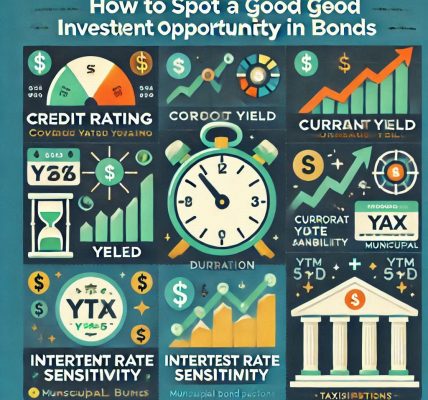Introduction
Market volatility can make even the most seasoned investors uneasy. During periods of uncertainty, fixed-income investments like bonds often become a preferred choice for preserving capital and generating stable returns. However, navigating a volatile market requires more than just investing in any bond — it demands a well-structured, diversified bond portfolio that can withstand economic fluctuations while maximizing returns.
In this comprehensive guide, we’ll explore strategies to build a resilient bond portfolio, understand the types of bonds to include, assess risk management techniques, and ensure your investments remain secure even during market turbulence.
🎯 Why Bonds Are Essential During Volatility
Bonds play a crucial role in protecting portfolios from extreme market swings by offering:
✅ Stable Income: Periodic interest payments regardless of market volatility.
✅ Capital Preservation: Principal repayment at maturity.
✅ Diversification Benefits: Low correlation with stocks reduces overall portfolio risk.
In a volatile market, a well-structured bond portfolio can act as a safety net, providing consistent returns and reducing exposure to equity market fluctuations.
📊 Key Factors to Consider Before Building a Bond Portfolio
Before selecting bonds, it’s essential to evaluate the following factors:
1. 📉 Interest Rate Environment
Interest rates have a direct impact on bond prices. When interest rates rise, bond prices fall, and vice versa.
✅ Rising Rate Strategy: Focus on floating-rate bonds or short-duration bonds to minimize price erosion.
✅ Declining Rate Strategy: Invest in long-duration, fixed-rate bonds to lock in higher yields.
2. 📈 Inflation Impact
Inflation erodes the purchasing power of fixed coupon payments, reducing real returns.
✅ Hedge Against Inflation: Include Treasury Inflation-Protected Securities (TIPS) or inflation-linked bonds.
3. 💸 Credit Risk and Default Probability
Bonds with higher yields may carry increased credit risk. Assess the issuer’s creditworthiness before investing.
✅ Mitigate Credit Risk: Opt for government bonds or investment-grade corporate bonds.
🛡️ 5 Steps to Build a Bulletproof Bond Portfolio
✅ Step 1: Diversify Across Bond Types and Sectors
A well-diversified bond portfolio reduces risk by spreading investments across various bond types, issuers, and sectors.
📝 Types of Bonds to Include:
- Government Bonds: Low-risk and backed by sovereign governments.
- Corporate Bonds: Higher yields but with increased credit risk.
- Municipal Bonds: Tax-free income for investors in high tax brackets.
- Inflation-Protected Bonds: Protects purchasing power against rising inflation.
- High-Yield Bonds: For aggressive investors seeking higher returns.
✅ Step 2: Balance Duration and Maturity for Risk Control
Duration measures a bond’s sensitivity to interest rate changes, while maturity indicates the time until principal repayment.
🕰️ Duration Management Strategies:
- Short-Term Bonds: Less price sensitivity but lower yields. Ideal during rising interest rates.
- Intermediate-Term Bonds: Balanced risk and return profile.
- Long-Term Bonds: Higher yields but greater interest rate risk. Suitable when rates are expected to decline.
✅ Pro Tip: Create a bond ladder by investing in bonds with staggered maturities to reduce reinvestment risk and maintain liquidity.
✅ Step 3: Incorporate Floating-Rate and Inflation-Linked Bonds
Floating-rate bonds (FRBs) and inflation-linked bonds protect against rising interest rates and inflation, making them ideal for volatile environments.
📚 Benefits of Floating-Rate Bonds:
- Coupons adjust periodically to reflect changes in benchmark rates.
- Less price sensitivity to rising interest rates.
📚 Benefits of Inflation-Linked Bonds:
- Protects real returns by adjusting principal and interest payments based on inflation.
✅ Step 4: Add High-Quality Corporate and Municipal Bonds for Yield
High-quality corporate and municipal bonds can provide higher returns while maintaining reasonable risk levels.
📝 Corporate Bond Strategy:
- Opt for investment-grade corporate bonds to balance risk and yield.
- Avoid speculative-grade or junk bonds during volatile markets.
🏙️ Municipal Bond Strategy:
- For investors in high tax brackets, municipal bonds offer tax-free income.
- Prioritize bonds issued by fiscally sound states or municipalities.
✅ Step 5: Implement Active Portfolio Monitoring and Rebalancing
Volatile markets require active management to ensure the portfolio remains aligned with investment objectives.
🔍 Monitoring Checklist:
- Interest Rate Movements: Adjust duration and maturity profiles based on rate expectations.
- Credit Quality Changes: Downgrade in issuer ratings may necessitate portfolio adjustments.
- Yield Curve Changes: Monitor shifts in the yield curve to identify potential opportunities.
✅ Pro Tip: Rebalance the bond portfolio annually to maintain diversification and risk alignment.
⚖️ Bond Portfolio Allocation Model for Volatile Markets
| Bond Type | Allocation (%) |
|---|---|
| Government Bonds | 30-40% |
| Corporate Bonds | 25-30% |
| Municipal Bonds | 10-15% |
| Floating-Rate Bonds | 10-15% |
| Inflation-Protected Bonds | 5-10% |
| High-Yield Bonds (Optional) | 5% |
📊 Strategies to Minimize Risks in a Volatile Market
1. 📉 Bond Laddering to Mitigate Interest Rate Risk
Bond laddering involves purchasing bonds with staggered maturities to ensure consistent income and reduce reinvestment risk.
✅ How It Works:
- Invest in bonds maturing at regular intervals (e.g., 1, 3, 5, and 10 years).
- As bonds mature, reinvest the proceeds into new bonds.
2. 🛡️ Use of Floating-Rate and Short-Duration Bonds
Floating-rate bonds protect against rising rates, while short-duration bonds reduce price sensitivity to interest rate changes.
✅ Ideal for Rising Rate Environments:
- Floating-rate bonds adjust their coupon payments to rising rates.
- Short-duration bonds mature quickly, reducing exposure to rate fluctuations.
3. 📝 Maintain High-Quality Bond Holdings
During volatile markets, it’s essential to prioritize bonds issued by reputable and financially stable issuers.
✅ Focus on Investment-Grade Bonds:
- Government and high-quality corporate bonds are less likely to default during economic downturns.
- Avoid speculative bonds with lower credit ratings.
⚡ Tax Implications to Consider When Building a Bond Portfolio
1. 📝 Tax Treatment of Interest Income
- Corporate Bond Interest: Taxable at ordinary income rates.
- Municipal Bond Interest: Often exempt from federal taxes and, in some cases, state and local taxes.
2. 💡 Capital Gains on Bond Sales
- Selling a bond before maturity at a profit triggers capital gains tax.
- Losses on bond sales may be used to offset capital gains.
✅ Pro Tip: Tax-loss harvesting can help minimize taxable income.
📚 Case Study: Building a Resilient Bond Portfolio During Volatility
Scenario:
- Investor A seeks to build a bond portfolio that generates stable income while minimizing exposure to rising interest rates.
- Market volatility and inflation concerns are key considerations.
✅ Portfolio Allocation:
- 40% Government Bonds (Low Risk)
- 25% Corporate Bonds (Higher Yield)
- 15% Floating-Rate Bonds (Protection Against Rising Rates)
- 10% Inflation-Protected Bonds (Hedge Against Inflation)
- 10% Municipal Bonds (Tax-Free Income)
🎉 Conclusion: Strengthen Your Bond Portfolio for Market Resilience
Building a bulletproof bond portfolio requires strategic diversification, active monitoring, and a balanced mix of fixed and floating-rate instruments. By considering factors like interest rates, inflation, and credit risk, investors can minimize volatility’s impact and achieve consistent, long-term returns. With the right bond allocation and risk management techniques, investors can navigate volatile markets and safeguard their financial future.



